High-Precision Remote Sensing Monitoring of Extent, Species, and Production of Cultured Seaweed for Korean Peninsula
Abstract
:1. Introduction
2. Materials and Methods
2.1. Study Area
2.2. Image Data
2.3. Image Selection and Processing
- (1)
- Temporal considerations: we selected images within the defined farming season (December to April) to ensure temporal alignment with seaweed cultivation activities. This alignment was critical for accurately capturing the spatial extent and phenological stages of seaweed farming.
- (2)
- Spatial resolution: Sentinel-2 imagery provides a spatial resolution of 10 m in the visible and near-infrared bands, which is suitable for identifying seaweed cultivation areas while minimizing interference from smaller non-aquaculture features.
- (3)
- Cloud cover and data quality: Cloud cover significantly impacts satellite image quality. Only images with cloud cover greater than 10%, acceptable atmospheric conditions, and minimal distortions were excluded from the analysis. For images with minor cloud presence, we applied cloud masking techniques using the Sentinel-2 Quality Assessment Band (QA60) to remove cloud-affected pixels while retaining usable data.
- (4)
- Seawater area masking: To improve classification accuracy and focus on seaweed cultivation areas, we applied an adjusted coastline mask to delineate the land–water boundary. This step removed land-based features from the analysis, ensuring that only seawater areas—where seaweed cultivation occurs—were considered in subsequent image processing.
2.4. Spectral Information and Classification Model
2.5. Species Identification
2.6. Production Estimation
2.7. Accuracy Assessment
3. Results
3.1. Classification Accuracy
3.2. The Spatial Distribution, Acreage, and Species Information of Cultured Seaweed
3.3. The Spatiotemporal Dynamics of Seaweed Cultivation
3.4. Association Between Cultivated Acreage and Production in South Korean Regions
3.5. Estimating the Seaweed Production in North Korea
4. Discussion
4.1. Model Performance and Feature Optimization for Seaweed Mapping
4.2. Improved Classification Strategy: Integration of Otsu Features and Multi-Temporal Analysis
4.3. Bridging the Data Gap: Efficient and Timely Monitoring of Seaweed Cultivation
4.4. Adaptive Remote Sensing Strategies for Seaweed Farm Monitoring Amidst Environmental Variability
5. Conclusions
Author Contributions
Funding
Data Availability Statement
Acknowledgments
Conflicts of Interest
Appendix A
| Years | Number of Scenes |
|---|---|
| 2017–2018 | 24 |
| 2018–2019 | 27 |
| 2019–2020 | 25 |
| 2020–2021 | 24 |
| 2021–2022 | 23 |
| 2022–2023 | 23 |
| Classification Model | Overall Accuracy (OA) | Kappa |
|---|---|---|
| Random forest | 0.99 | 0.98 |
| Support vector machine | 0.89 | 0.85 |
| Decision tree | 0.97 | 0.94 |
References
- Choudhary, P.; Khade, M.; Savant, S.; Musale, A.; Chelliah, M.S.; Dasgupta, S. Empowering Blue Economy: From Underrated Ecosystem to Sustainable Industry. J. Environ. Manag. 2021, 291, 112697. [Google Scholar] [CrossRef] [PubMed]
- Xiao, X.; Agustí, S.; Yu, Y.; Huang, Y.; Chen, W.; Hu, J.; Li, C.; Li, K.; Wei, F.; Lu, Y.; et al. Seaweed Farms Provide Refugia from Ocean Acidification. Sci. Total Environ. 2021, 776, 145192. [Google Scholar] [CrossRef] [PubMed]
- Krause-Jensen, D.; Duarte, C.M. Substantial Role of Macroalgae in Marine Carbon Sequestration. Nat. Geosci. 2016, 9, 737–742. [Google Scholar] [CrossRef]
- Macreadie, P.I.; Anton, A.; Raven, J.A.; Beaumont, N.; Connolly, R.M.; Friess, D.A.; Kelleway, J.J.; Kennedy, H.; Kuwae, T.; Lavery, P.S.; et al. The Future of Blue Carbon Science. Nat. Commun. 2019, 10, 3998. [Google Scholar] [CrossRef]
- Mashoreng, S.; Nafie, Y.A.L.; Isyrini, R. Cultivated Seaweed Carbon Sequestration Capacity. IOP Conf. Ser. Earth Environ. Sci. 2019, 370, 012017. [Google Scholar] [CrossRef]
- Duarte, C.M.; Losada, I.J.; Hendriks, I.E.; Mazarrasa, I.; Marbà, N. The Role of Coastal Plant Communities for Climate Change Mitigation and Adaptation. Nat. Clim. Change 2013, 3, 961–968. [Google Scholar] [CrossRef]
- Duarte, C.M.; Wu, J.; Xiao, X.; Bruhn, A.; Krause-Jensen, D. Can Seaweed Farming Play a Role in Climate Change Mitigation and Adaptation? Front. Mar. Sci. 2017, 4, 100. [Google Scholar] [CrossRef]
- Froehlich, H.E.; Afflerbach, J.C.; Frazier, M.; Halpern, B.S. Blue Growth Potential to Mitigate Climate Change through Seaweed Offsetting. Curr. Biol. 2019, 29, 3087–3093.e3. [Google Scholar] [CrossRef]
- Wu, J.; Zhang, H.; Pan, Y.; Krause-Jensen, D.; He, Z.; Fan, W.; Xiao, X.; Chung, I.; Marbà, N.; Serrano, O.; et al. Opportunities for Blue Carbon Strategies in China. Ocean Coast. Manag. 2020, 194, 105241. [Google Scholar] [CrossRef]
- Yong, W.T.L.; Thien, V.Y.; Rupert, R.; Rodrigues, K.F. Seaweed: A Potential Climate Change Solution. Renew. Sustain. Energy Rev. 2022, 159, 112222. [Google Scholar] [CrossRef]
- Cotas, J.; Gomes, L.; Pacheco, D.; Pereira, L. Ecosystem Services Provided by Seaweeds. Hydrobiology 2023, 2, 75–96. [Google Scholar] [CrossRef]
- Wernberg, T.; Thomsen, M.S.; Kotta, J. Complex Plant–Herbivore–Predator Interactions in a Brackish Water Seaweed Habitat. J. Exp. Mar. Biol. Ecol. 2013, 449, 51–56. [Google Scholar] [CrossRef]
- Al, M.A.; Akhtar, A.; Rahman, M.F.; Kamal, A.H.M.; Karim, N.U.; Hassan, M.L. Habitat Structure and Diversity Patterns of Seaweeds in the Coastal Waters of Saint Martin’s Island, Bay of Bengal, Bangladesh. Reg. Stud. Mar. Sci. 2020, 33, 100959. [Google Scholar] [CrossRef]
- Dijkstra, J.A.; Harris, L.G.; Mello, K.; Litterer, A.; Wells, C.; Ware, C. Invasive Seaweeds Transform Habitat Structure and Increase Biodiversity of Associated Species. J. Ecol. 2017, 105, 1668–1678. [Google Scholar] [CrossRef]
- Radulovich, R.; Umanzor, S.; Cabrera, R.; Mata, R. Tropical Seaweeds for Human Food, Their Cultivation and Its Effect on Biodiversity Enrichment. Aquaculture 2015, 436, 40–46. [Google Scholar] [CrossRef]
- Racine, P.; Marley, A.; Froehlich, H.E.; Gaines, S.D.; Ladner, I.; MacAdam-Somer, I.; Bradley, D. A Case for Seaweed Aquaculture Inclusion in U.S. Nutrient Pollution Management. Mar. Policy 2021, 129, 104506. [Google Scholar] [CrossRef]
- Xiao, X.; Agusti, S.; Lin, F.; Li, K.; Pan, Y.; Yu, Y.; Zheng, Y.; Wu, J.; Duarte, C.M. Nutrient Removal from Chinese Coastal Waters by Large-Scale Seaweed Aquaculture. Sci. Rep. 2017, 7, 46613. [Google Scholar] [CrossRef]
- Zhu, Y.; Wang, Z.; Song, L.; Christakos, G.; Agusti, S.; Duarte, C.; Wu, J. Dynamics of Phytoplankton Community in Relation to Seasonal Variation and Laminaria Japonica Culturing in Coastal Area. Estuar. Coast. Shelf Sci. 2022, 277, 108063. [Google Scholar] [CrossRef]
- Farghali, M.; Mohamed, I.M.A.; Osman, A.I.; Rooney, D.W. Seaweed for Climate Mitigation, Wastewater Treatment, Bioenergy, Bioplastic, Biochar, Food, Pharmaceuticals, and Cosmetics: A Review. Environ. Chem. Lett. 2023, 21, 97–152. [Google Scholar] [CrossRef]
- Duarte, C.M.; Bruhn, A.; Krause-Jensen, D. A Seaweed Aquaculture Imperative to Meet Global Sustainability Targets. Nat. Sustain. 2021, 5, 185–193. [Google Scholar] [CrossRef]
- Kim, K.Y.; Kim, K.Y. Harnessing Seaweed Farming for Climate Mitigation in South Korea: Evaluating Carbon Dioxide Removal Potential and Future Research Directions. Algae 2024, 39, 329–347. [Google Scholar] [CrossRef]
- Hwang, E.K.; Choi, H.G.; Kim, J.K. Seaweed Resources of Korea. Bot. Mar. 2020, 63, 395–405. [Google Scholar] [CrossRef]
- Hwang, E.K.; Boo, G.H.; Graf, L.; Yarish, C.; Yoon, H.S.; Kim, J.K. Kelps in Korea: From Population Structure to Aquaculture to Potential Carbon Sequestration. Algae 2022, 37, 85–103. [Google Scholar] [CrossRef]
- Statistical Yearbook of Oceans and Fisheries 2023. Available online: https://www.mof.go.kr/statPortal/stp/cts/anr/statsAnlrpt.do (accessed on 29 March 2024).
- FishStat: Global Aquaculture Production 1950–2022. Available online: https://www.fao.org/fishery/en/statistics/software/fishstatj (accessed on 29 March 2024).
- Nagahawatta, D.P.; Liyanage, N.M.; Jayawardena, T.U.; Yang, F.; Jayawardena, H.H.a.C.K.; Kurera, M.J.M.S.; Wang, F.; Fu, X.; Jeon, Y.-J.; Nagahawatta, D.P.; et al. Functions and Values of Sulfated Polysaccharides from Seaweed. Algae 2023, 38, 217–240. [Google Scholar] [CrossRef]
- Lee, H.-G.; Nagahawatta, D.P.; Liyanage, N.M.; Jayawardhana, H.H.A.C.K.; Yang, F.; Je, J.-G.; Kang, M.-C.; Kim, H.-S.; Jeon, Y.-J.; Lee, H.-G.; et al. Structural Characterization and Anti-Inflammatory Activity of Fucoidan Isolated from Ecklonia maxima Stipe. Algae 2022, 37, 239–247. [Google Scholar] [CrossRef]
- Park, M.; Shin, S.K.; Do, Y.H.; Yarish, C.; Kim, J.K. Application of Open Water Integrated Multi-Trophic Aquaculture to Intensive Monoculture: A Review of the Current Status and Challenges in Korea. Aquaculture 2018, 497, 174–183. [Google Scholar] [CrossRef]
- Hwang, E.K.; Park, C.S. Seaweed Cultivation and Utilization of Korea. ALGAE 2020, 35, 107–121. [Google Scholar] [CrossRef]
- Assefa, A.; Haile, A.T.; Dhanya, C.T.; Walker, D.W.; Gowing, J.; Parkin, G. Impact of Sustainable Land Management on Vegetation Cover Using Remote Sensing in Magera Micro Watershed, Omo Gibe Basin, Ethiopia. Int. J. Appl. Earth Obs. Geoinform. 2021, 103, 102495. [Google Scholar] [CrossRef]
- Aurin, D.A.; Dierssen, H.M. Advantages and Limitations of Ocean Color Remote Sensing in CDOM-Dominated, Mineral-Rich Coastal and Estuarine Waters. Remote Sens. Environ. 2012, 125, 181–197. [Google Scholar] [CrossRef]
- Cheng, X.; Yang, J.; Han, Z.; Shi, G.; Pan, D.; Meng, L.; Zeng, Z.; Shen, Z. Optimizing Rural Waste Management: Leveraging High-Resolution Remote Sensing and GIS for Efficient Collection and Routing. Int. J. Appl. Earth Obs. Geoinform. 2024, 135, 104219. [Google Scholar] [CrossRef]
- Hossain, M.S.; Hashim, M. Potential of Earth Observation (EO) Technologies for Seagrass Ecosystem Service Assessments. Int. J. Appl. Earth Obs. Geoinform. 2019, 77, 15–29. [Google Scholar] [CrossRef]
- Pasqualini, V.; Pergent-Martini, C.; Fernandez, C.; Pergent, G. The Use of Airborne Remote Sensing for Benthic Cartography: Advantages and Reliability. Int. J. Remote Sens. 1997, 18, 1167–1177. [Google Scholar] [CrossRef]
- Virtriana, R.; Anggraini, T.S.; Ihsan, K.T.N.; Alifah, M.N.; Retnowati, D.A.; Rohayani, P.; Harto, A.B.; Riqqi, A. Developing a Spatial-Based Predictive Model for Conservation Area Management Prioritization Using Ecosystem Service and Site Suitability Index in Java Island. Int. J. Appl. Earth Obs. Geoinform. 2024, 126, 103606. [Google Scholar] [CrossRef]
- Wang, K.; Franklin, S.E.; Guo, X.; Cattet, M. Remote Sensing of Ecology, Biodiversity and Conservation: A Review from the Perspective of Remote Sensing Specialists. Sensors 2010, 10, 9647–9667. [Google Scholar] [CrossRef]
- Xie, Y.; Sha, Z.; Yu, M. Remote Sensing Imagery in Vegetation Mapping: A Review. J. Plant Ecol. 2008, 1, 9–23. [Google Scholar]
- Duan, H.; Yang, C.; Yu, X. Evaluation of Historical and Future Coastal Wetland Change in the Yellow and Bohai Seas Using Satellite Images and a Land Use Model. J. Environ. Manag. 2024, 351, 119986. [Google Scholar] [CrossRef]
- Mahrad, B.E.; Newton, A.; Icely, J.; Kacimi, I.; Abalansa, S.; Snoussi, M. Contribution of Remote Sensing Technologies to a Holistic Coastal and Marine Environmental Management Framework: A Review. Remote Sens. 2020, 12, 2313. [Google Scholar] [CrossRef]
- Bai, J.; Li, Y.; Chen, S.; Du, J.; Wang, D. Long-Time Monitoring of Seagrass Beds on the East Coast of Hainan Island Based on Remote Sensing Images. Ecol. Indic. 2023, 157, 111272. [Google Scholar] [CrossRef]
- Li, Q.; Jin, R.; Ye, Z.; Gu, J.; Dan, L.; He, J.; Christakos, G.; Agusti, S.; Duarte, C.M.; Wu, J. Mapping Seagrass Meadows in Coastal China Using GEE. Geocarto Int. 2022, 37, 12602–12617. [Google Scholar] [CrossRef]
- Pu, R.; Bell, S. Mapping Seagrass Coverage and Spatial Patterns with High Spatial Resolution IKONOS Imagery. Int. J. Appl. Earth Obs. Geoinform. 2017, 54, 145–158. [Google Scholar] [CrossRef]
- Topouzelis, K.; Makri, D.; Stoupas, N.; Papakonstantinou, A.; Katsanevakis, S. Seagrass Mapping in Greek Territorial Waters Using Landsat-8 Satellite Images. Int. J. Appl. Earth Obs. Geoinform. 2018, 67, 98–113. [Google Scholar] [CrossRef]
- Wang, X.; Xiao, X.; Zou, Z.; Chen, B.; Ma, J.; Dong, J.; Doughty, R.B.; Zhong, Q.; Qin, Y.; Dai, S.; et al. Tracking Annual Changes of Coastal Tidal Flats in China during 1986–2016 through Analyses of Landsat Images with Google Earth Engine. Remote Sens. Environ. 2020, 238, 110987. [Google Scholar] [CrossRef] [PubMed]
- Chen, G.; Jin, R.; Ye, Z.; Li, Q.; Gu, J.; Luo, M.; Luo, Y.; Christakos, G.; Morris, J.; He, J.; et al. Spatiotemporal Mapping of Salt Marshes in the Intertidal Zone of China during 1985–2019. J. Remote Sens. 2022, 2022, 9793626. [Google Scholar] [CrossRef]
- Chen, C.; Ma, Y.; Yu, D.; Hu, Y.; Ren, L. Tracking Annual Dynamics of Carbon Storage of Salt Marsh Plants in the Yellow River Delta National Nature Reserve of China Based on Sentinel-2 Imagery during 2017–2022. Int. J. Appl. Earth Obs. Geoinform. 2024, 130, 103880. [Google Scholar] [CrossRef]
- Stückemann, K.-J.; Waske, B. Mapping Lower Saxony’s Salt Marshes Using Temporal Metrics of Multi-Sensor Satellite Data. Int. J. Appl. Earth Obs. Geoinform. 2022, 115, 103123. [Google Scholar] [CrossRef]
- Sunkur, R.; Kantamaneni, K.; Bokhoree, C.; Rathnayake, U.; Fernando, M. Mangrove Mapping and Monitoring Using Remote Sensing Techniques towards Climate Change Resilience. Sci. Rep. 2024, 14, 6949. [Google Scholar] [CrossRef]
- Zheng, Y.; Takeuchi, W. Quantitative Assessment and Driving Force Analysis of Mangrove Forest Changes in China from 1985 to 2018 by Integrating Optical and Radar Imagery. ISPRS Int. J. Geo-Inf. 2020, 9, 513. [Google Scholar] [CrossRef]
- Duan, Y.; Li, X.; Zhang, L.; Chen, D.; Liu, S.; Ji, H. Mapping National-Scale Aquaculture Ponds Based on the Google Earth Engine in the Chinese Coastal Zone. Aquaculture 2020, 520, 734666. [Google Scholar] [CrossRef]
- Luo, J.; Sun, Z.; Lu, L.; Xiong, Z.; Cui, L.; Mao, Z. Rapid Expansion of Coastal Aquaculture Ponds in Southeast Asia: Patterns, Drivers and Impacts. J. Environ. Manag. 2022, 315, 115100. [Google Scholar] [CrossRef]
- Alexandridis, T.K.; Topaloglou, C.A.; Lazaridou, E.; Zalidis, G.C. The Performance of Satellite Images in Mapping Aquacultures. Ocean Coast. Manag. 2008, 51, 638–644. [Google Scholar] [CrossRef]
- Cheng, J.; Jia, N.; Chen, R.; Guo, X.; Ge, J.; Zhou, F. High-Resolution Mapping of Seaweed Aquaculture along the Jiangsu Coast of China Using Google Earth Engine (2016–2022). Remote Sens. 2022, 14, 6202. [Google Scholar] [CrossRef]
- Liu, Y.; Wang, Z.; Yang, X.; Zhang, Y.; Yang, F.; Liu, B.; Cai, P. Satellite-Based Monitoring and Statistics for Raft and Cage Aquaculture in China’s Offshore Waters. Int. J. Appl. Earth Obs. Geoinform. 2020, 91, 102118. [Google Scholar] [CrossRef]
- Zheng, Y.; Wu, J.; Wang, A.; Chen, J. Object- and Pixel-Based Classifications of Macroalgae Farming Area with High Spatial Resolution Imagery. Geocarto Int. 2018, 33, 1048–1063. [Google Scholar] [CrossRef]
- Xing, Q.; An, D.; Zheng, X.; Wei, Z.; Wang, X.; Li, L.; Tian, L.; Chen, J. Monitoring Seaweed Aquaculture in the Yellow Sea with Multiple Sensors for Managing the Disaster of Macroalgal Blooms. Remote Sens. Environ. 2019, 231, 111279. [Google Scholar] [CrossRef]
- Innocentini, M.M.; Rodrigues, E.F.; Mathion, J.K.; Caritá, E.C.; Simão, L.; Marins, M. Analysis of Multispectral Indices as a Tool for Segmenting and Quantifying the Seaweed Kappaphycus Alvarezii in a Commercial Cultivation System. Biomass 2024, 4, 933–946. [Google Scholar] [CrossRef]
- Zhu, H.; Lu, Z.; Zhang, C.; Yang, Y.; Zhu, G.; Zhang, Y.; Liu, H. Remote Sensing Classification of Offshore Seaweed Aquaculture Farms on Sample Dataset Amplification and Semantic Segmentation Model. Remote Sens. 2023, 15, 4423. [Google Scholar] [CrossRef]
- Sui, B.; Jiang, T.; Zhang, Z.; Pan, X.; Liu, C. A Modeling Method for Automatic Extraction of Offshore Aquaculture Zones Based on Semantic Segmentation. ISPRS Int. J. Geo-Inf. 2020, 9, 145. [Google Scholar] [CrossRef]
- Cui, B.; Fei, D.; Shao, G.; Lu, Y.; Chu, J. Extracting Raft Aquaculture Areas from Remote Sensing Images via an Improved U-Net with a PSE Structure. Remote Sens. 2019, 11, 2053. [Google Scholar] [CrossRef]
- López-Leyva, R.; Rojas-Domínguez, A.; Flores-Mendoza, J.P.; Casillas-Araiza, M.Á.; Santiago-Montero, R. Comparing Threshold-Selection Methods for Image Segmentation: Application to Defect Detection in Automated Visual Inspection Systems. In Pattern Recognition; Springer: Cham, Switzerland, 2016; pp. 33–43. [Google Scholar]
- Tan, Z.; Zhang, D. A Fuzzy Adaptive Gravitational Search Algorithm for Two-Dimensional Multilevel Thresholding Image Segmentation. J. Ambient Intell. Humaniz. Comput. 2020, 11, 4983–4994. [Google Scholar] [CrossRef]
- Kaur, G.; Kumar, R. Comparative Analysis of Image Segmentation Using Thresholding. Int. J. Eng. Appl. Sci. IJEAS 2020, 7, 28–34. [Google Scholar] [CrossRef]
- Singh, S.; Mittal, N.; Singh, H.; Oliva, D. Improving the Segmentation of Digital Images by Using a Modified Otsu’s between-Class Variance. Multimed. Tools Appl. 2023, 82, 40701–40743. [Google Scholar] [CrossRef]
- Xu, X.; Xu, S.; Jin, L.; Song, E. Characteristic Analysis of Otsu Threshold and Its Applications. Pattern Recognit. Lett. 2011, 32, 956–961. [Google Scholar] [CrossRef]
- Kim, B.-T.; Han, I.-S.; Lee, J.-S.; Kim, D.-H. Impact of Seawater Temperature on Korean Aquaculture under Representative Concentration Pathways (RCPs) Scenarios. Aquaculture 2021, 542, 736893. [Google Scholar] [CrossRef]
- Huang, S.; Tang, L.; Hupy, J.P.; Wang, Y.; Shao, G. A Commentary Review on the Use of Normalized Difference Vegetation Index (NDVI) in the Era of Popular Remote Sensing. J. For. Res. 2021, 32, 1–6. [Google Scholar] [CrossRef]
- Kriegler, F.J.; Malila, W.A.; Nalepka, R.F.; Richardson, W. Preprocessing Transformations and Their Effects on Multispectral Recognition. In Proceedings of the Remote Sensing of Environment, VI, Ann Arbor, MI, USA, 13–16 October 1969; p. 97. [Google Scholar]
- McFeeters, S.K. The Use of the Normalized Difference Water Index (NDWI) in the Delineation of Open Water Features. Int. J. Remote Sens. 1996, 17, 1425–1432. [Google Scholar] [CrossRef]
- Otsu, N. A Threshold Selection Method from Gray-Level Histograms. IEEE Trans. Syst. Man Cybern. 1979, 9, 62–66. [Google Scholar] [CrossRef]
- Huang, M.; Yu, W.; Zhu, D. An Improved Image Segmentation Algorithm Based on the Otsu Method. In Proceedings of the 2012 13th ACIS International Conference on Software Engineering, Artificial Intelligence, Networking and Parallel/Distributed Computing, Kyoto, Japan, 8–10 August 2012; pp. 135–139. [Google Scholar]
- Singh, N.; Bhandari, A.K.; Kumar, I.V. Fusion-Based Contextually Selected 3D Otsu Thresholding for Image Segmentation. Multimed. Tools Appl. 2021, 80, 19399–19420. [Google Scholar] [CrossRef]
- Breiman, L. Random Forests. Mach. Learn. 2001, 45, 5–32. [Google Scholar] [CrossRef]
- Ho, T.K. The Random Subspace Method for Constructing Decision Forests. IEEE Trans. Pattern Anal. Mach. Intell. 1998, 20, 832–844. [Google Scholar] [CrossRef]
- Belgiu, M.; Drăguţ, L. Random Forest in Remote Sensing: A Review of Applications and Future Directions. ISPRS J. Photogramm. Remote Sens. 2016, 114, 24–31. [Google Scholar] [CrossRef]
- Pelletier, C.; Valero, S.; Inglada, J.; Champion, N.; Dedieu, G. Assessing the Robustness of Random Forests to Map Land Cover with High Resolution Satellite Image Time Series over Large Areas. Remote Sens. Environ. 2016, 187, 156–168. [Google Scholar] [CrossRef]
- Sohn, C.-H. Porphyra, Undaria and Hizikia Cultivation in Korea. Algae 1993, 8, 207–216. [Google Scholar]
- Choi, H.G.; Kim, Y.S.; Lee, S.J.; Nam, K.W. Growth and Reproductive Patterns of Undaria Pinnatifida Sporophytes in a Cultivation Farm in Busan, Korea. J. Appl. Phycol. 2007, 19, 131–138. [Google Scholar] [CrossRef]
- Kim, S.H.; Kim, Y.D.; Hwang, M.S.; Hwang, E.K.; Yoo, H.I. Temperature Ranges for Survival and Growth of Juvenile Saccharina Sculpera (Laminariales, Phaeophyta) and Applications for Field Cultivation. Algae 2021, 36, 231–240. [Google Scholar] [CrossRef]
- World Bank Climate Change Knowledge Portal. Available online: https://climateknowledgeportal.worldbank.org/ (accessed on 17 February 2025).
- El-Manaway, I.M.; Rashedy, S.H. The Ecology and Physiology of Seaweeds: An Overview. In Sustainable Global Resources of Seaweeds Volume 1; Springer: Cham Switzerland, 2022; pp. 3–16. ISBN 978-3-030-91955-9. [Google Scholar]
- Korea’s Dried Seaweed Exports Reach All-Time Record in 2024—The Korea Times. Available online: https://www.koreatimes.co.kr/www/nation/2025/02/113_387071.html (accessed on 17 February 2025).
- South Korea, Ministry of Oceans and Fisheries. Public Waters Management and Reclamation Act. Available online: https://elaw.klri.re.kr/eng_mobile/viewer.do?hseq=46970&type=part&key=35 (accessed on 17 February 2025).
- South Korea, Ministry of Oceans and Fisheries. Fishing Management and Promotion Act. Available online: https://elaw.klri.re.kr/eng_mobile/viewer.do?hseq=56301&type=part&key=27 (accessed on 17 February 2025).
- South Korea, Ministry of Oceans and Fisheries. Act on Experiments and Research for the Promotion of Science and Technology of Fisheries. Available online: https://faolex.fao.org/docs/pdf/kor168039.pdf (accessed on 17 February 2025).
- South Korea, Ministry of Oceans and Fisheries. Fishery Resources Management Act. Available online: https://elaw.klri.re.kr/eng_service/lawView.do?hseq=36363&lang=ENG (accessed on 17 February 2025).
- 2050 Carbon Neutral Strategy of the Republic of Korea|UNFCCC. Available online: https://unfccc.int/documents/267683 (accessed on 17 February 2025).
- South Korea, Ministry of Oceans and Fisheries. Sustainable Management of Ocean and Achievement of Maritime Safety. Available online: https://www.mof.go.kr (accessed on 17 February 2025).
- Vapnik, V.N. The Support Vector Method. In Artificial Neural Networks—ICANN’97; Gerstner, W., Germond, A., Hasler, M., Nicoud, J.-D., Eds.; Lecture Notes in Computer Science; Springer: Berlin/Heidelberg, Germany, 1997; Volume 1327, pp. 261–271. ISBN 978-3-540-63631-1. [Google Scholar]
- Quinlan, J.R. Induction of Decision Trees. Mach. Learn. 1986, 1, 81–106. [Google Scholar] [CrossRef]
- Blaschke, T.; Hay, G.J.; Kelly, M.; Lang, S.; Hofmann, P.; Addink, E.; Feitosa, R.Q.; Van der Meer, F.; Van der Werff, H.; Van Coillie, F.; et al. Geographic Object-Based Image Analysis—Towards a New Paradigm. ISPRS J. Photogramm. Remote Sens. 2014, 87, 180–191. [Google Scholar] [CrossRef]



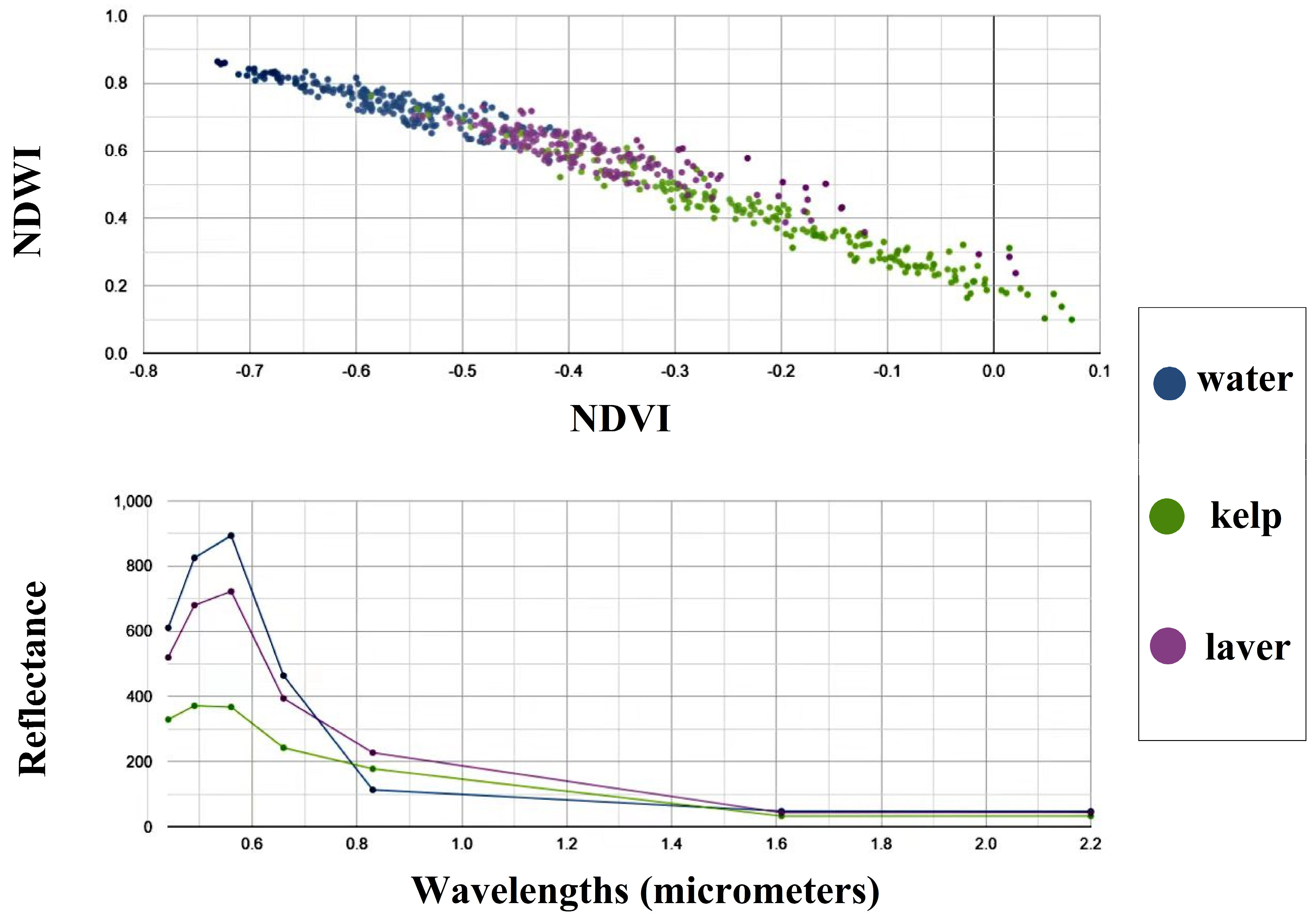
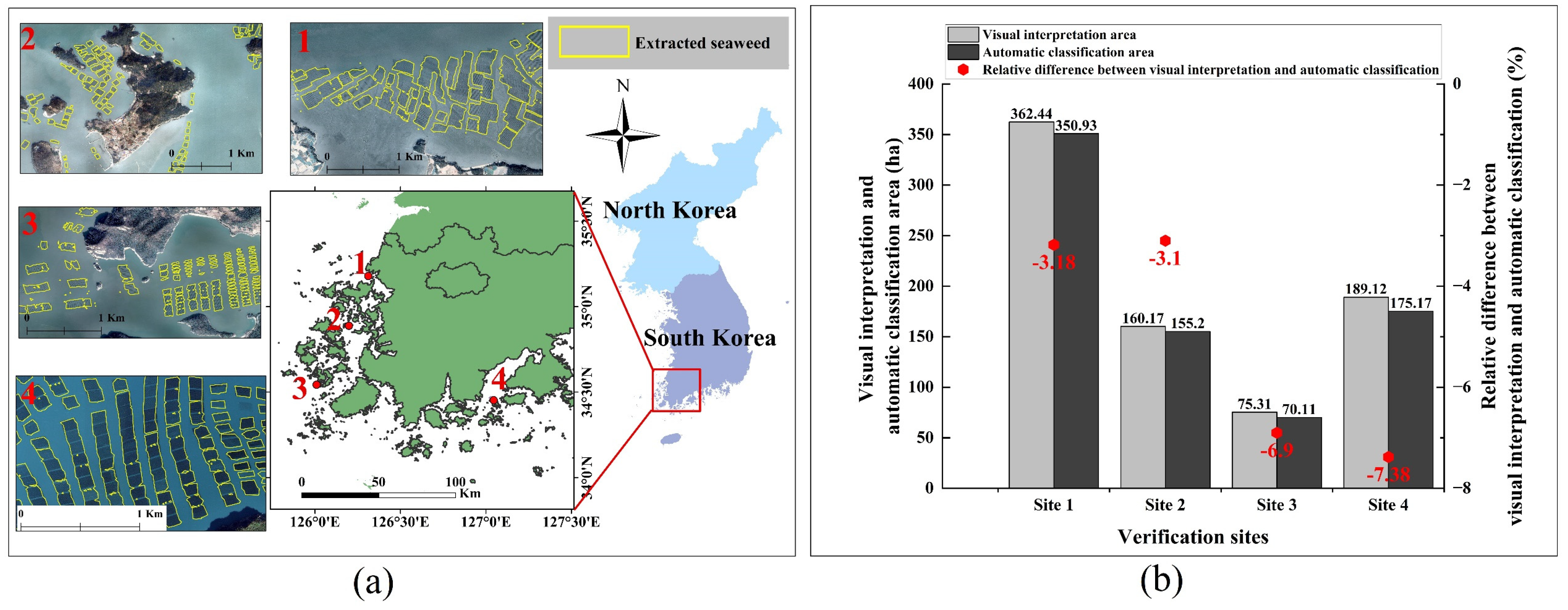

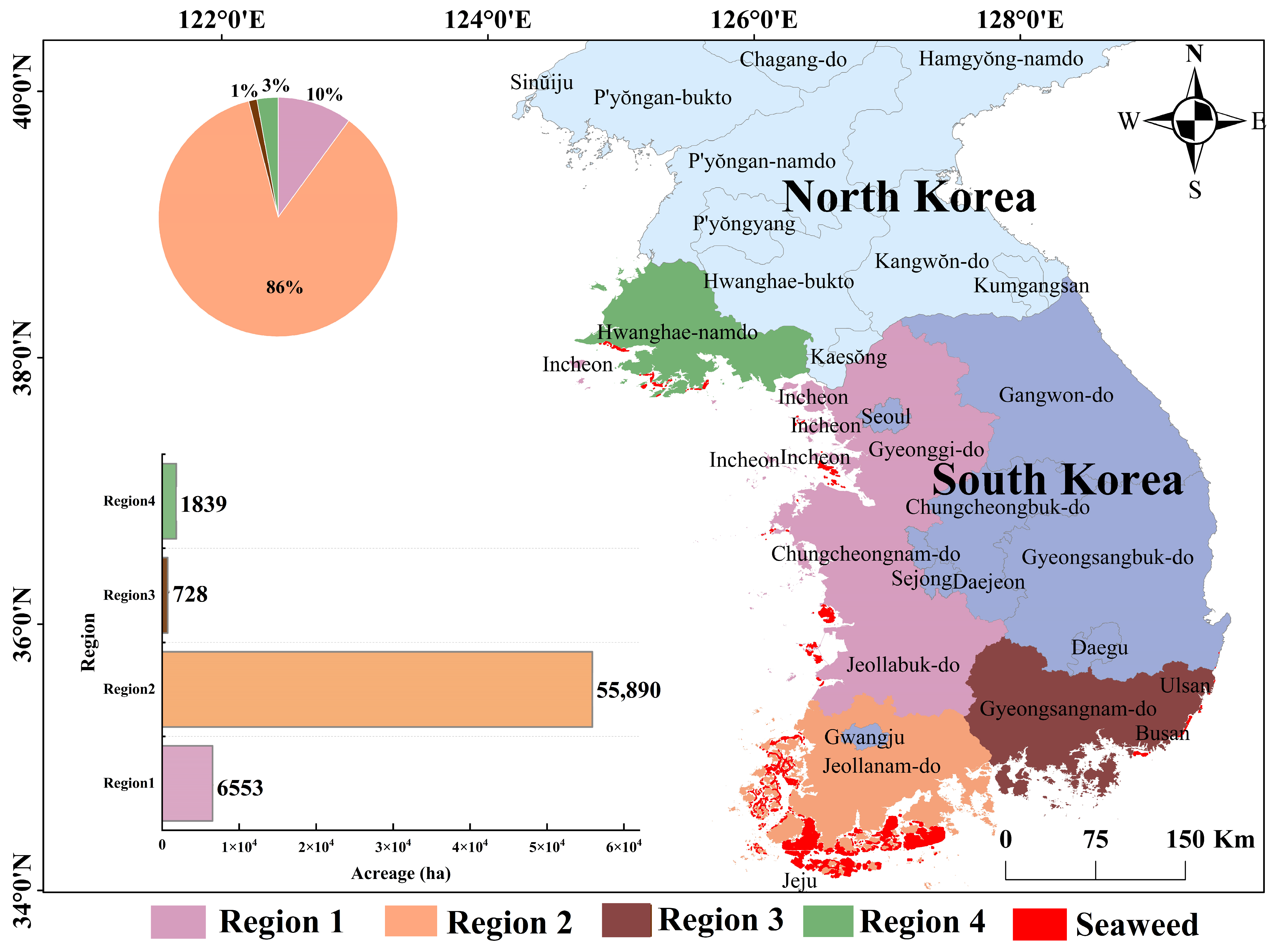
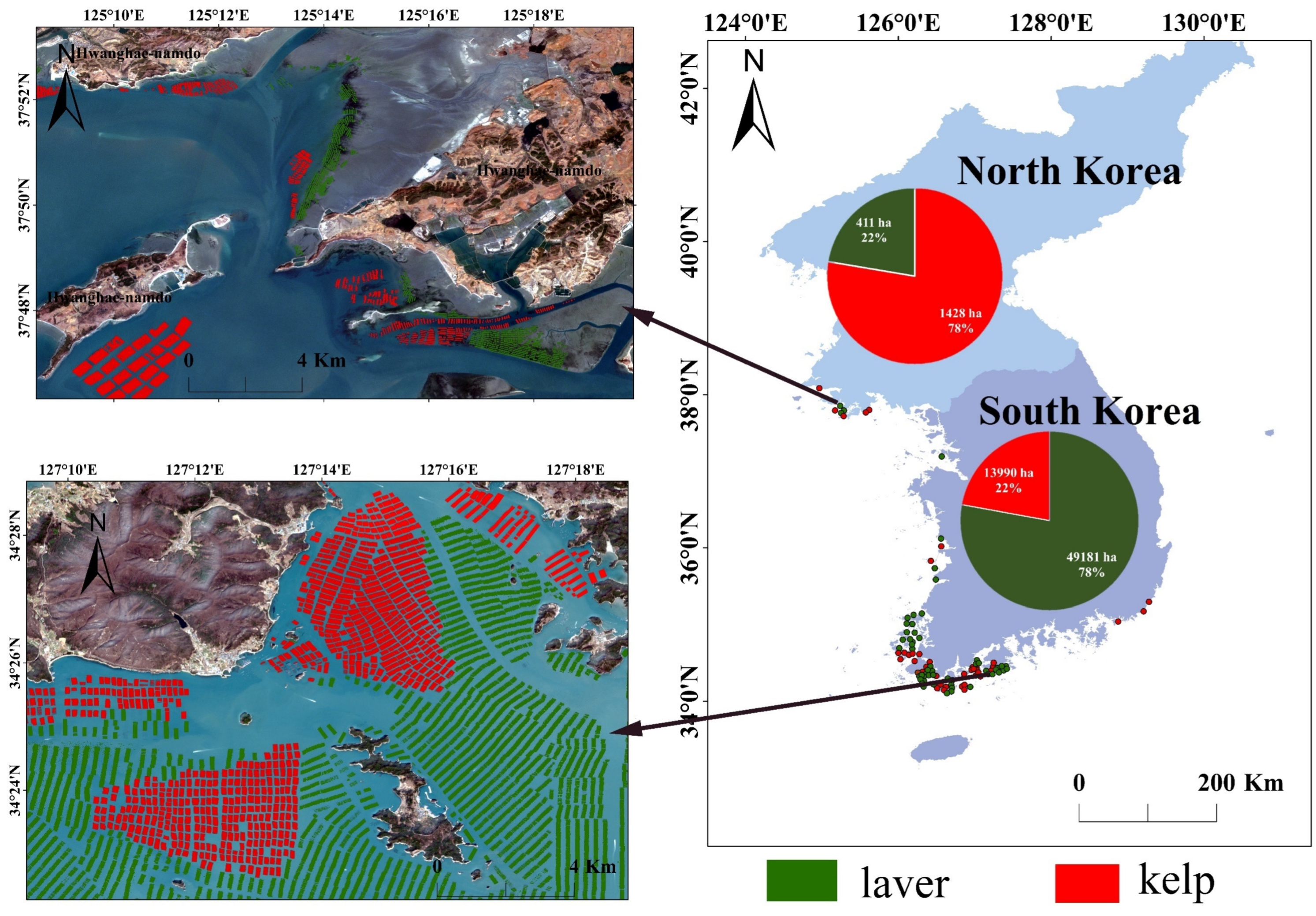
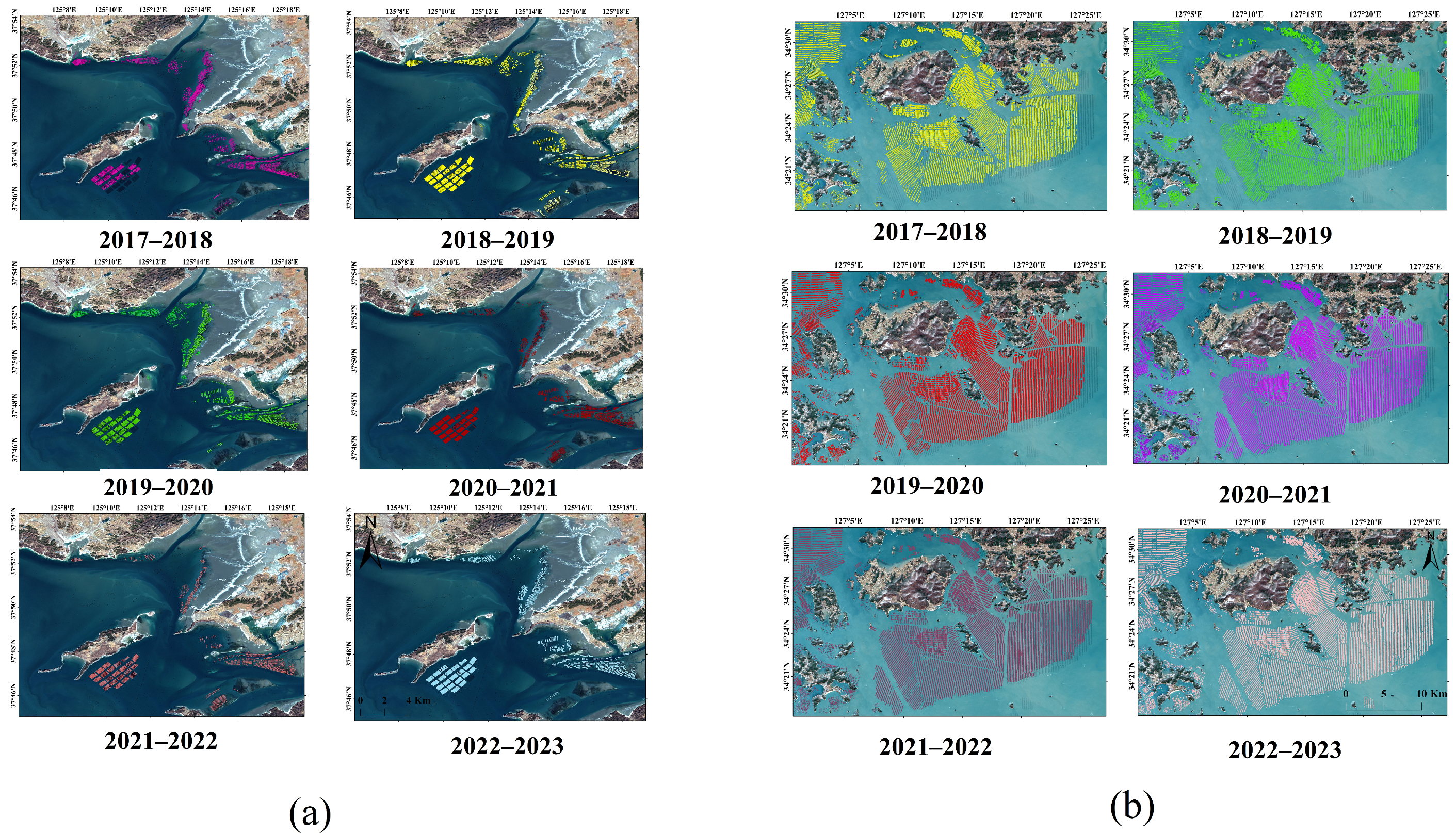
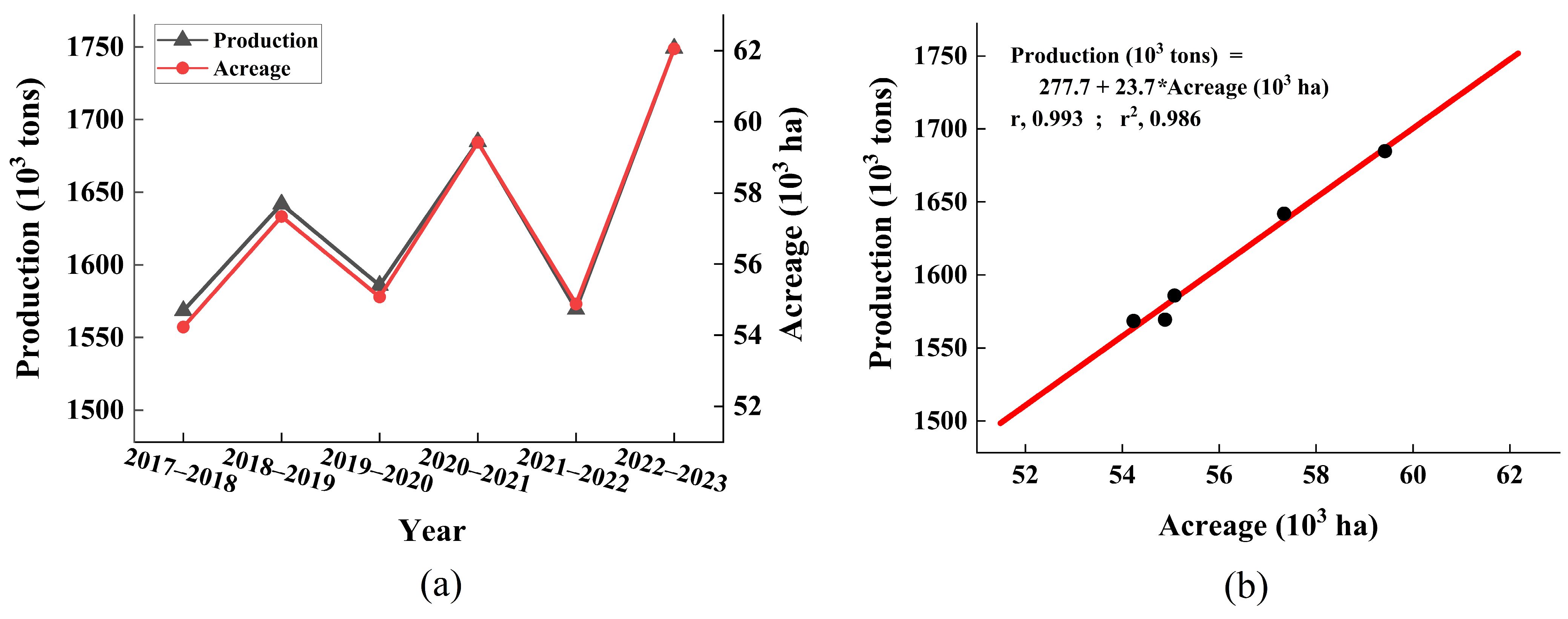
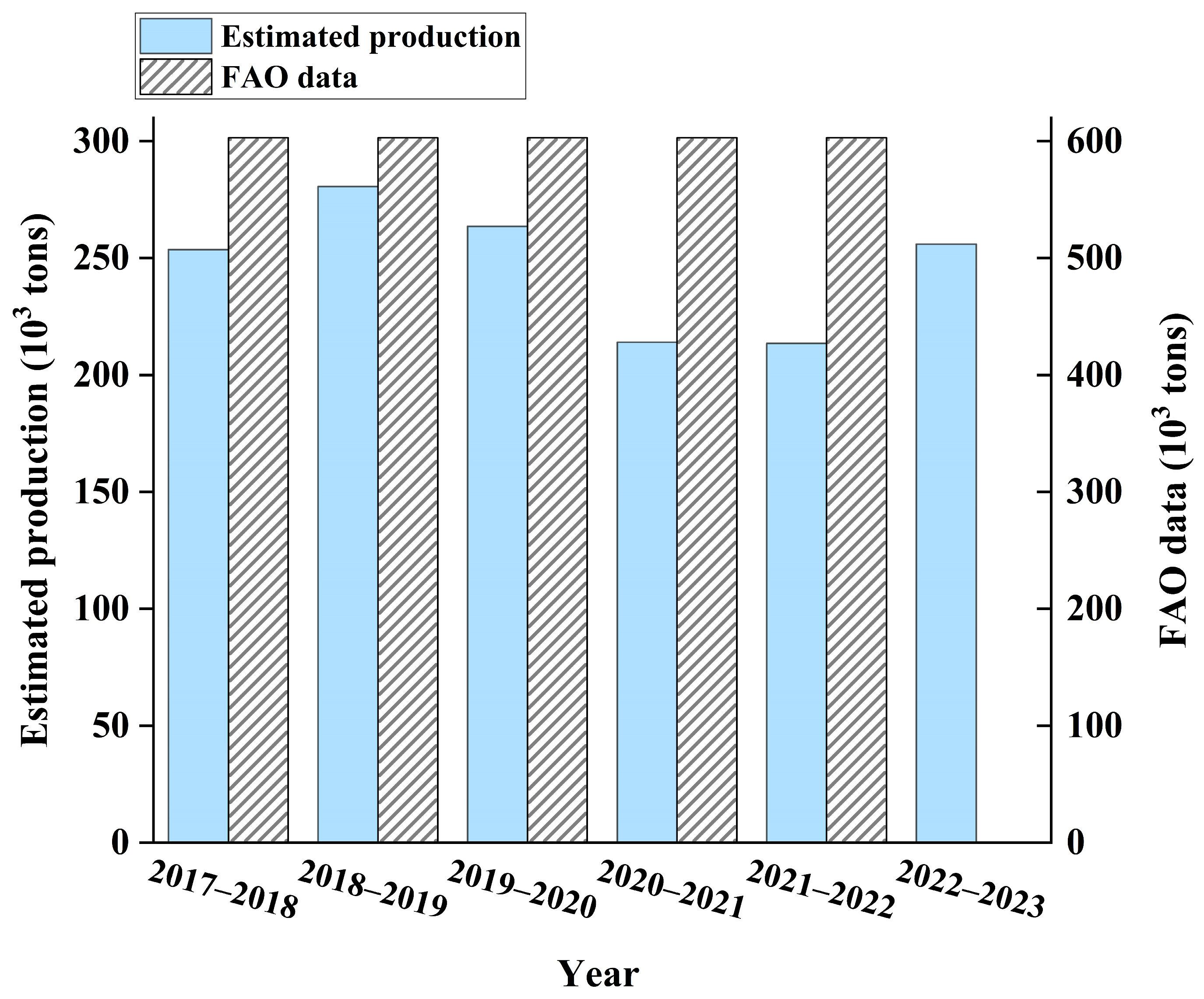

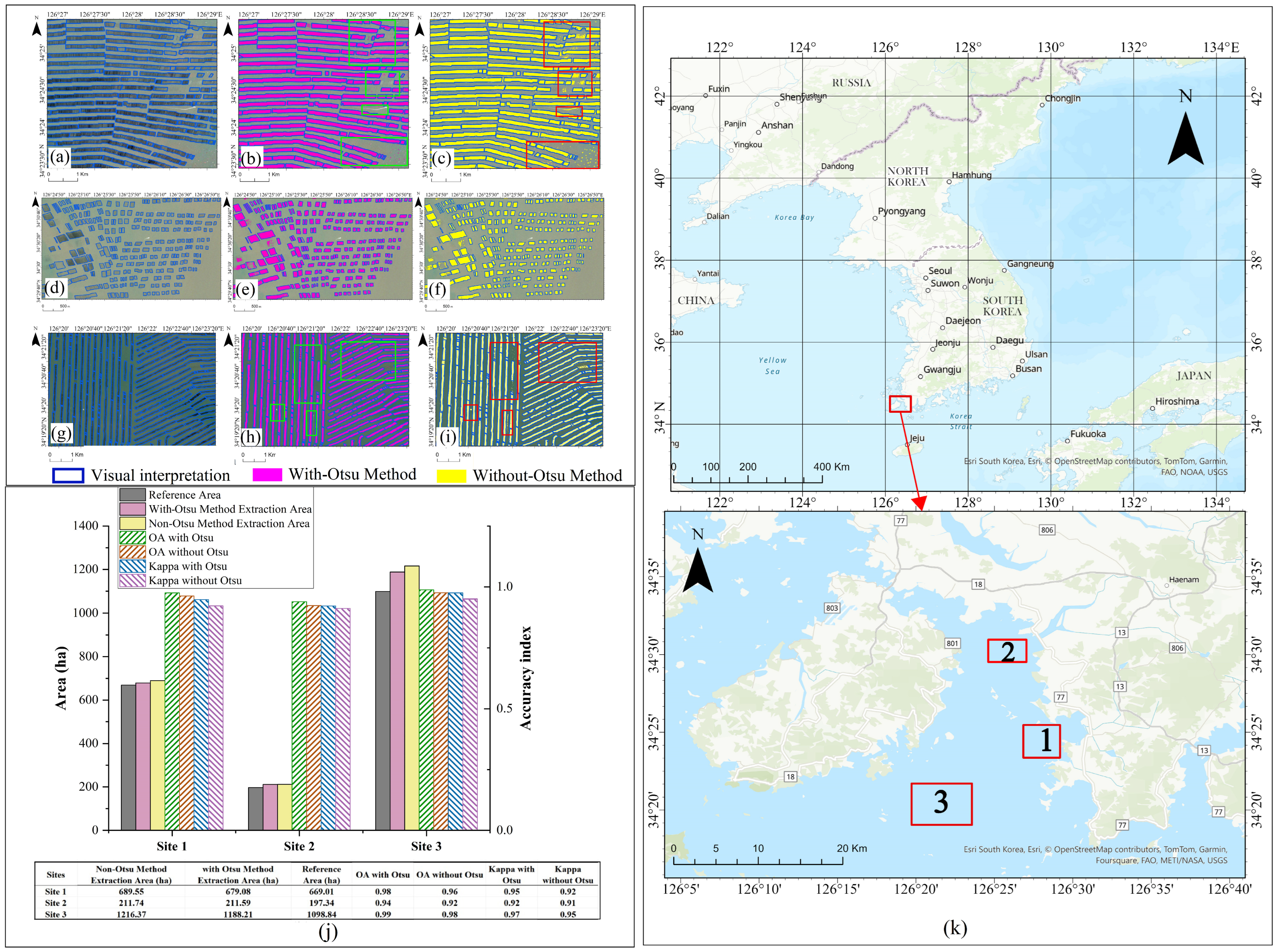
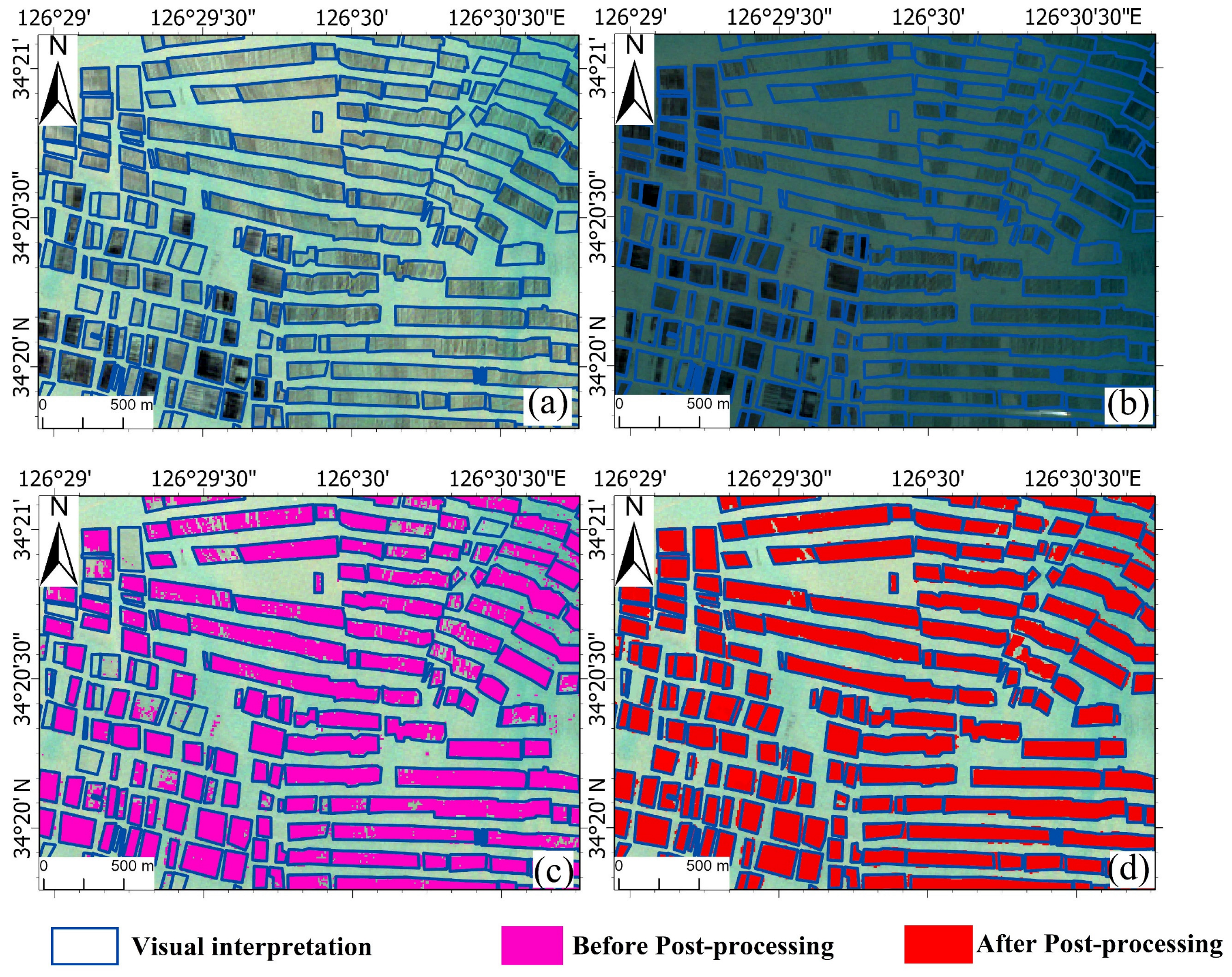
| Species | Farming Methods | Growing Period |
|---|---|---|
| Pyropia | Fixing pole system or floating system | November–April |
| Saccharina | Longline system | December–May |
| Undaria | Longline system | December–July |
| Band Combination | Overall Accuracy (OA) | Kappa |
|---|---|---|
| B2, B3, B4, B8, NDVI, NDWI, OTSU * | 0.99 | 0.98 |
| B2, B3, B4 | 0.98 | 0.96 |
| B2, B3, B5, B8 | 0.97 | 0.94 |
| B2, B4, B5, B8 | 0.97 | 0.94 |
| B2, B5, B8, B11 | 0.95 | 0.90 |
| B3, B4, B8, B11 | 0.98 | 0.96 |
Disclaimer/Publisher’s Note: The statements, opinions and data contained in all publications are solely those of the individual author(s) and contributor(s) and not of MDPI and/or the editor(s). MDPI and/or the editor(s) disclaim responsibility for any injury to people or property resulting from any ideas, methods, instructions or products referred to in the content. |
© 2025 by the authors. Licensee MDPI, Basel, Switzerland. This article is an open access article distributed under the terms and conditions of the Creative Commons Attribution (CC BY) license (https://creativecommons.org/licenses/by/4.0/).
Share and Cite
Chen, S.; Ye, Z.; Jin, R.; Zhu, J.; Wang, N.; Zheng, Y.; He, J.; Wu, J. High-Precision Remote Sensing Monitoring of Extent, Species, and Production of Cultured Seaweed for Korean Peninsula. Remote Sens. 2025, 17, 1150. https://doi.org/10.3390/rs17071150
Chen S, Ye Z, Jin R, Zhu J, Wang N, Zheng Y, He J, Wu J. High-Precision Remote Sensing Monitoring of Extent, Species, and Production of Cultured Seaweed for Korean Peninsula. Remote Sensing. 2025; 17(7):1150. https://doi.org/10.3390/rs17071150
Chicago/Turabian StyleChen, Shuangshuang, Zhanjiang Ye, Runjie Jin, Junjie Zhu, Nan Wang, Yuhan Zheng, Junyu He, and Jiaping Wu. 2025. "High-Precision Remote Sensing Monitoring of Extent, Species, and Production of Cultured Seaweed for Korean Peninsula" Remote Sensing 17, no. 7: 1150. https://doi.org/10.3390/rs17071150
APA StyleChen, S., Ye, Z., Jin, R., Zhu, J., Wang, N., Zheng, Y., He, J., & Wu, J. (2025). High-Precision Remote Sensing Monitoring of Extent, Species, and Production of Cultured Seaweed for Korean Peninsula. Remote Sensing, 17(7), 1150. https://doi.org/10.3390/rs17071150







